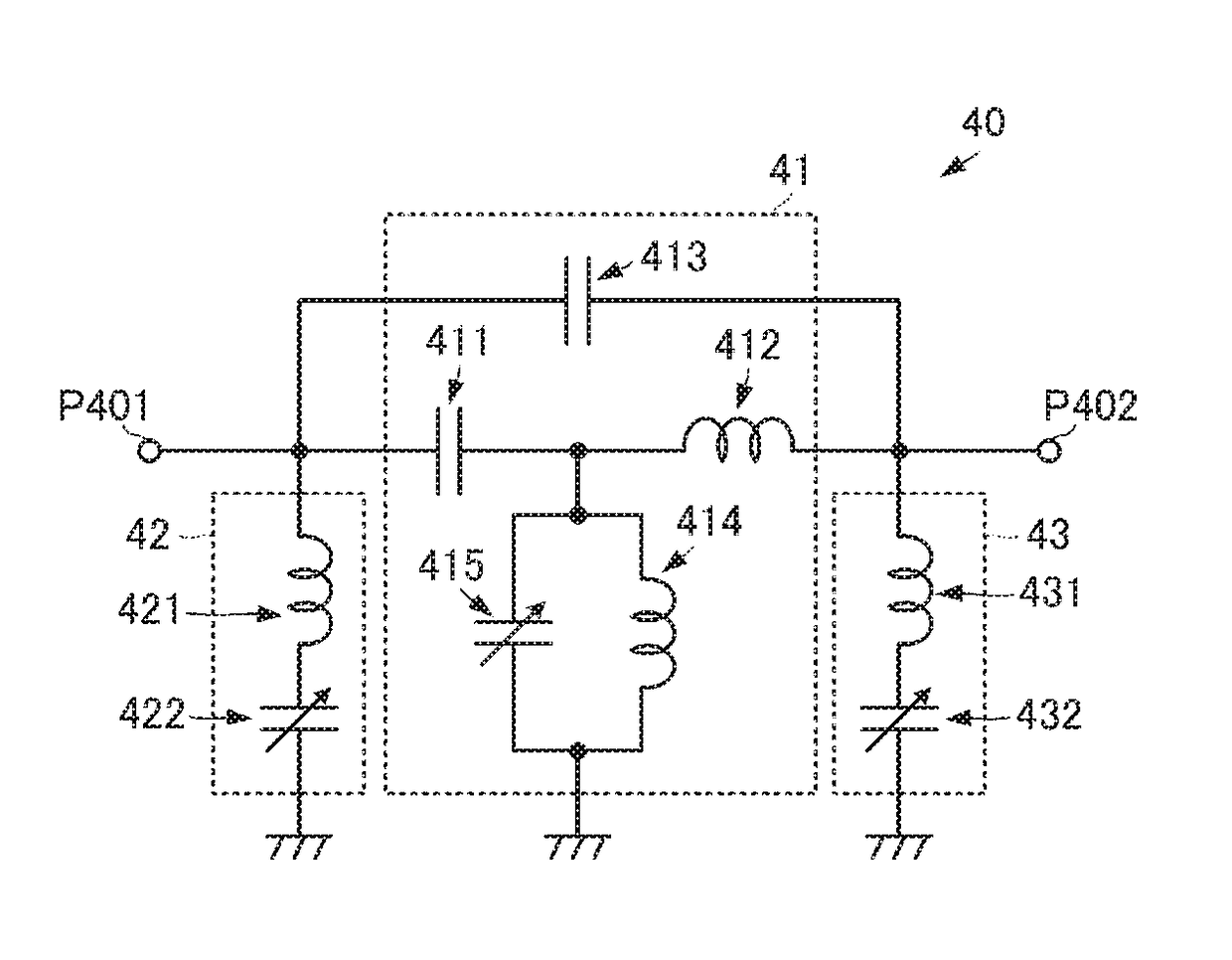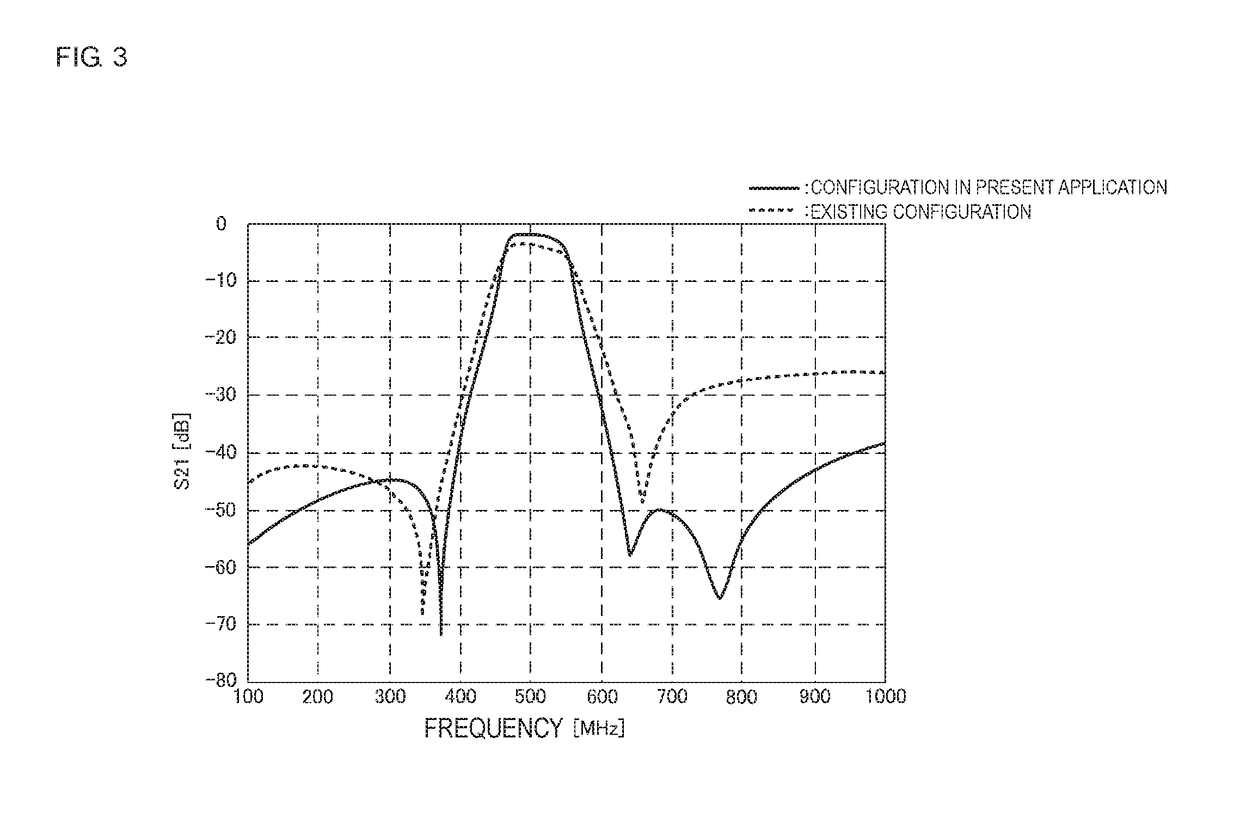Frequency-variable lc filter and high-frequency front end circuit
a filter and frequency variable technology, applied in filters, multiple-port networks, electrical equipment, etc., can solve the problems of increasing circuit size and and achieve the effect of reducing the steepness of attenuation characteristics, reducing the size of simple configuration, and reducing the loss of bandpass characteristics
- Summary
- Abstract
- Description
- Claims
- Application Information
AI Technical Summary
Benefits of technology
Problems solved by technology
Method used
Image
Examples
first embodiment
[0085]FIG. 2 is a graph illustrating bandpass characteristics of the frequency-variable LC filter in the present disclosure. As illustrated in FIG. 2, usage of the frequency-variable LC filter 40 can form the attenuation poles at both sides of the pass band with a pass band width of approximately 100 [MHz]. Furthermore, the attenuation can be made difficult to be decreased in frequency bands at the opposite sides to the pass band with respect to the respective attenuation poles and desired attenuation can be realized in a wide frequency band. In addition, the attenuation can be increased at both of the high frequency side and the low frequency side of the pass band and the frequency band in which the desired attenuation is provided can be enlarged.
[0086]In particular, as illustrated in FIG. 1, the inductor 412 of the first series arm LC filter circuit 41 is directly connected to the second connection terminal P402 without necessarily the capacitor interposed therebetween, thereby ma...
second embodiment
[0099]The bandpass characteristics as illustrated in FIG. 5 are provided by causing the inductor 412 that is directly connected to the second connection terminal P402 to be magnetically coupled with another inductor as described above. FIG. 5 is a graph illustrating the bandpass characteristics of the frequency-variable LC filter in the present disclosure. As illustrated in FIG. 5, usage of the configuration of the frequency-variable LC filter 40A, 40B, or 40C can make the attenuation characteristics steeper while maintaining low loss in the pass band in comparison with a mode that is not magnetically coupled.
[0100]The inductor 412 is caused to be magnetically coupled with another inductor in the embodiment. However, inductors that are caused to be magnetically coupled with each other among the inductor in the first parallel arm LC filter circuit, the inductor in the LC series circuit, the inductor in the LC parallel circuit, and the inductor in the second parallel arm LC filter cir...
fourth embodiment
[0137]Next, FIG. 11A is a circuit diagram of a frequency-variable LC filter 40F according to the present disclosure.
[0138]The frequency-variable LC filter 40F is different from the frequency-variable LC filter 40 in the first embodiment in a point that it includes a first parallel arm LC filter circuit 42F in order to further improve the steepness of the attenuation characteristics. The first parallel arm LC filter circuit 42F is configured by adding a fixed capacitor 423 to the first parallel arm LC filter circuit 42.
[0139]As illustrated in FIG. 11A, the fixed capacitor 423 is connected in parallel to a series circuit formed by the inductor 421 and the variable capacitor 422. A frequency at an anti-resonant point of a circuit formed by the inductor 421 and the fixed capacitor 423 is set to the low frequency side of a pass band of the frequency-variable LC filter 40F. This makes the attenuation characteristics of the frequency-variable LC filter 40F at the low frequency side of the ...
PUM
 Login to View More
Login to View More Abstract
Description
Claims
Application Information
 Login to View More
Login to View More - R&D
- Intellectual Property
- Life Sciences
- Materials
- Tech Scout
- Unparalleled Data Quality
- Higher Quality Content
- 60% Fewer Hallucinations
Browse by: Latest US Patents, China's latest patents, Technical Efficacy Thesaurus, Application Domain, Technology Topic, Popular Technical Reports.
© 2025 PatSnap. All rights reserved.Legal|Privacy policy|Modern Slavery Act Transparency Statement|Sitemap|About US| Contact US: help@patsnap.com



